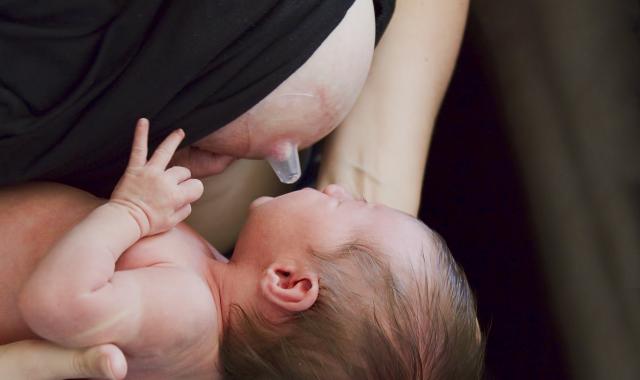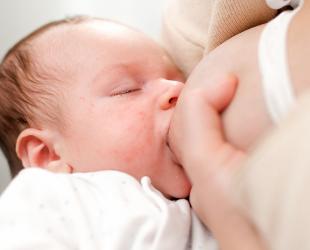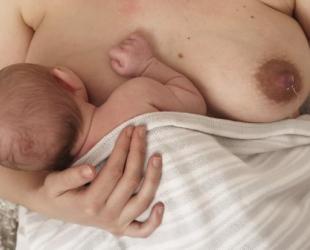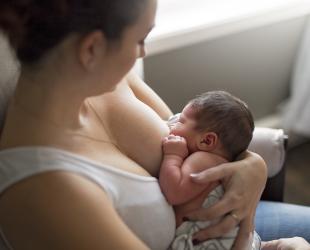Do I really need a nipple shield?

A nipple shield is a thin flexible silicone cover, placed over the nipple before baby attaches. It has holes to allow milk to flow through.
The shield is shaped like a hat with a brim and a crown. Some shields have cut-out sections around the brim that allows your baby's nose and/or chin to touch your skin rather than the nipple shield.
When is a nipple shield used?
A nipple shield may be suggested for a variety of reasons and when other options have not worked to fix the nipple or attachment problem. A nipple shield is usually only used once your milk supply has increased in amount and changed from colostrum to mature milk. This usually happens 2 to 5 days after the birth. In most cases, you only need to use a nipple shield for a short time.
Breastfeeding experts have different opinions about nipple shields and when/if they should be tried. Some of the reasons for using them include:
-
sore, damaged nipples
-
attachment issues (e.g. flat or inverted nipples, baby having mouth variations such as a high palate or because of being premature)
-
a baby learning to feed at the breast after using a bottle.
Some mothers find they can solve these issues with skin-to-skin contact, improving positioning and attachment and helping their let-down reflex.

Concerns with the use of a nipple shield
The older types of shields were made of hard plastic or thick rubber. This affected how well a baby could drain the breast and so a mum’s milk supply could reduce over time.
With the newer thin silicone nipple shields, this doesn't happen as much. However, your baby may still take a little longer to feed than they would without it, as the nipple shield will still slow the flow a bit.
If your baby’s attachment is still not great, then they may not get as much milk. It's important to check the signs that your baby is getting enough.
How to use a nipple shield
Nipple shields come in different shapes and sizes and you need to have the right one for you and your baby. A shield that isn't suitable will damage your nipples further.
You will also need to learn how to use the nipple shield properly. Have a face-to-face consultation with a lactation consultant, breastfeeding counsellor or doctor who is a lactation expert. They will help you choose the most suitable nipple shield and make sure your baby is well attached with it.
Tips for using a nipple shield
-
Express a few drops of your breastmilk onto the inside of the nipple shield. This will help prevent rubbing and improve the seal that the nipple shield makes with your breast.
-
Express a few drops of your breastmilk on to the tip of the nipple shield where the holes are, to encourage your baby to attach.
-
Stretch the brim of the nipple shield outwards.
-
Keep the brim stretched and place the nipple shield centrally over your nipple and onto your breast. This will help draw some of your nipple and areola into the crown of the shield as you release the stretch.
-
Position any ‘cut-outs’ where your baby's chin and nose will touch your breast.
-
Flatten the ‘brim’ of the shield over your breast. Hold the nipple shield in place with your fingers on the outside edges.
-
There should be a small space between the end of your nipple and the end of the crown of the nipple shield. If your nipple touches the end of the crown of the nipple shield, then the nipple shield is too small for you.
-
Point the crown of the nipple shield at your baby's nose and encourage your baby to open their mouth wide. As baby attaches, the nipple shield can be directed towards the roof of your baby's mouth.
Signs that your baby is well attached to the breast:
-
Your baby’s mouth is open wide with a good mouthful of your breast. Their lips are over the brim of the nipple shield, not just the crown portion and their bottom lip is turned out.
-
Their chin is pressed into your breast.
-
Their tongue is forward over the lower gum and cupping the nipple shield. (This may be difficult to see when they’re attached well).
-
You may notice your baby’s whole jaw moving as they suck. They will not be sucking in air or slipping off the nipple shield.
-
You will see baby swallowing (when the lower jaw pauses slightly in mid-suck) and you may also be able to hear the swallowing (soft ticking sound).
-
At the end of the breastfeed, your nipple should feel fine with no rubbing or pain.
-
The crown of the nipple shield usually has milk in it at the end of the breastfeed if your breastmilk was coming through the shield.
Cleaning a nipple shield
You don’t need to sterilise a nipple shield. With clean hands, just rinse it in cold water after use. Then wash it in hot soapy water and rinse under hot running water. Drain, dry (e.g. with paper towel) and store in a covered container that has been cleaned in the same way.
Weaning off a nipple shield
Weaning off a nipple shield can be a bit difficult so you may find it helpful to get the support of a breastfeeding counsellor or lactation consultant.
When it comes to weaning off a nipple shield, try some of these ideas:
-
Remove the nipple shield part way through the breastfeed and keep feeding without it.
-
Have as much skin-to-skin contact between you and your baby as possible so they can use their instincts to find your breast.
-
Offer your baby a breastfeed as soon as they wake from sleep (and try without the shield).
-
Offer a breastfeed while walking around.
-
Express a few drops of your breastmilk onto your nipple just before a breastfeed.
-
Feed your baby as soon as they start to show feeding cues.
-
Have patience. Have a go at attaching your baby without the shield as often as you can. If it doesn’t work, don’t persist until your baby is upset. Simply use the nipple shield again and try again later.
© Australian Breastfeeding Association May 2022



